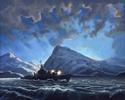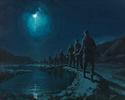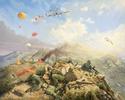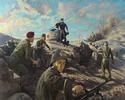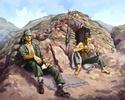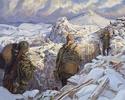Youth Remember the Korean War Armistice
A Brush with the Korean War - Hill 355
Aim
To familiarize students with the contributions and sacrifices made by Canadians at Hill 355 during the Korean War.
Learning outcomes:
Students will be expected to demonstrate an understanding of the experiences of Canadians at Hill 355 during the Korean War and our soldiers’ sacrifices and achievements.
Target audience
This activity is aimed at youth aged 12 to 18 years.
Materials
- Historical sheet: Canada Remembers Hill 355
- Video: Hill 355
- The war painting Incoming, by Edward (Ted) Zuber
A Brush with the Korean War online Art Gallery
Sequence of activities and anticipated time frame: [approximately 60 minutes]
- Introductory discussion (10 minutes)
- Reading activity: (10 minutes total)
- Viewing a video (3 minutes, 49 seconds)
- A brush with Hill 355 - image study (15 minutes)
- Follow-up discussion (15 minutes)
Introductory Discussion [10 minutes]
At the end of the Second World War, Japan’s empire was dismantled and the Soviet Union, seeking to gain influence in the region, occupied North Korea while the Americans moved into South Korea. The Soviets and the Americans eventually left, but not until a communist government had been established in the North and a democratic government in the South. Tensions between the two Koreas grew to a climax and on June 25, 1950, the military forces of North Korea crossed the 38th Parallel into South Korea. This marked the beginning of hostilities which were to rage on for more than three years, throughout the country known to its people as the Land of the Morning Calm.
Every war has specific battles or events that are familiar to most people. In the First World War some think of Vimy Ridge and Passchendaele. In the Second World War, some might think of the landings on D-Day and the Liberation of the Netherlands. In the Korean War, it is the actions at Hill 355 that stand out in Canadian memory.
Reading Activity [15 minutes]
Ask students to read the historical sheet Canada Remembers Hill 355 to become more familiar with our soldiers’ experiences at Hill 355 during the Korean War.
Viewing a video [3 minutes, 49 seconds]
What better way to learn about history than hear it directly from those who experienced it! Students will become familiar with Canadian soldiers’ experiences at Hill 355 by now watching the Land of the Morning Calm video Hill 355.
A brush with Hill 355 - image study
For hundreds of years, war artists have been painting and documenting the stories and experiences of war. In the Korean War, we had Ted Zuber. He was a parachutist who went to serve in Korea in 1952 as a sniper with the Royal Canadian Regiment. Although not an official war artist, he brought along a sketch book to record what he saw.
Once home, his sketches inspired him to create paintings about the Canadians’ wartime experience. These paintings became what are called his “Korean War Memoirs.” In addition to recalling his own combat experiences, Zuber talked to other Veterans who had fought there and studied aerial photographs, maps, and war diaries to help him “paint” the Korean War.
Share the image Incoming. This painting shows the soldiers reacting to the attack at Hill 355 in October 1952. The 45-minute continuous attack was one of the heaviest that Canadians endured in Korea.
Study the image. Look closely at the expressions on their faces. Having listened to the Veterans experiences, how do you think these soldiers were feeling during this battle? Fear? Anxiety? Bravery?
Discuss how the battle looked. The Canadians were greatly outnumbered and the enemy was hitting them hard. Our soldiers could have run away, panicked, or given up. Instead, they stayed and fought courageously against all odds.
Follow-up discussion [15 minutes]
Ask students to reflect on the following statement: The action at Hill 355 in October 1952 took a heavy toll. 18 Canadians were killed, 35 wounded and 14 men taken prisoner.
Then lead a discussion based on the following questions:
- Do you think the sacrifices of Canadians in uniform during the Korean War were worth it? Is war ever worth it? Does anyone win in war?
- What do you imagine the people of South Korea think about the Canadians who fought so hard and sacrificed so greatly to help their country so that they could have their rights and freedoms back?
- Do you think it is important to remember the Canadians who served in the Korean War?
- How should youth of today express how they remember events like the Korean War? Can you think of any special new ways to remember those who served?
Possible extension activities
There are a number of ways you could extend this lesson. For example, you could ask youth to imagine that they are war correspondents covering the Korean War and then have them file news reports on the events that took place there. These could be in the form of mock newspaper articles, radio broadcasts or newsreels. Alternately, they could imagine that they fought in Korea and were writing home to tell their family or friends what they had just been through. Or they could imagine that they are a loved one writing to a Canadian soldier in Korea asking if he is okay, what it was like and how he is feeling.
Inviting a Veteran who took part in the Korean War to be a guest speaker would be an exceptional opportunity to learn first-hand what it was like to serve in the cause of peace and freedom during the conflict. For more information visit the Memory Project Speakers Bureau website.
You may wish to further explore more of the Korean War experience with your students by having them view more of Ted Zuber’s artwork in our Brush with the Korean War online art gallery. He has several paintings of soldiers, not only in battle but also during quieter times, living on the front lines.
- Date modified:
